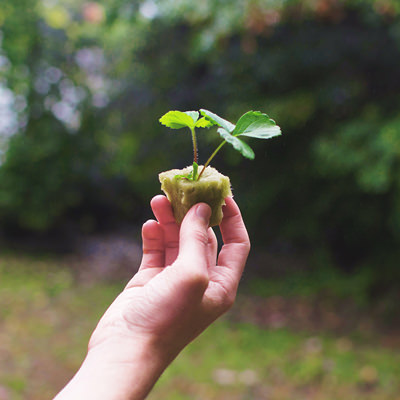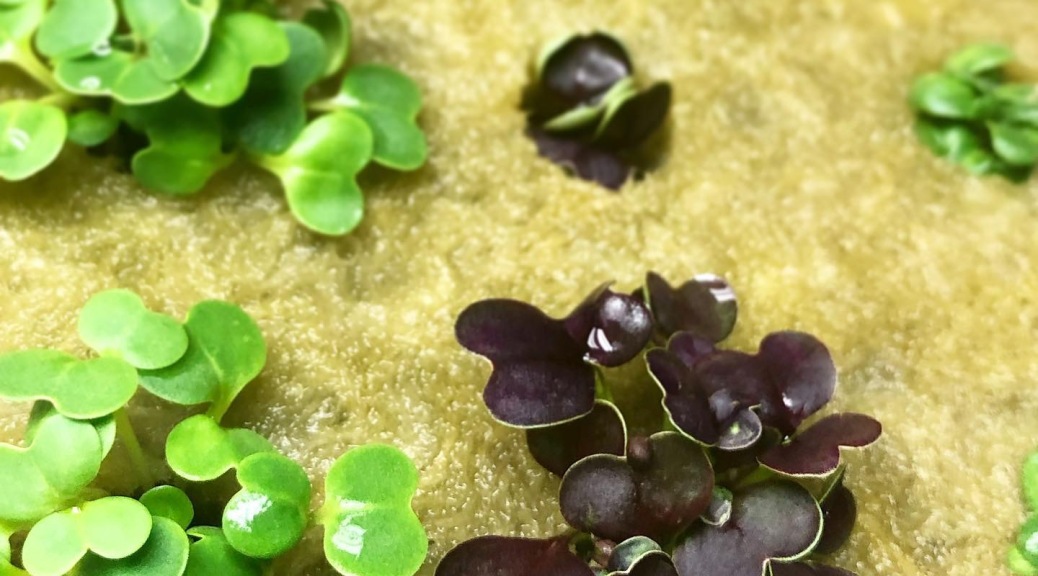Congratulations! You are here because you are empowered to grow your own healthy and pure raw food whether it be a vegetable, greens, fruit, or herb!
Starting your plants from seed can save you a lot of money in the long run — it just takes a little bit of know-how to get going if you’ve never done it before. One thing to note, this seed starting how-to is specific to hydroponic Tower Garden growers and uses rock wool as a growing medium to start seeds in. If you want to learn more about rock wool, click here. Remember, we are here to help in any way we can so be sure to reach out to us in the comments below if you have a question along your journey to growing your own food.

Helpful Links:
- Rock Wool: What is it? How do I use it?
- Soil Temperature Conditions for Vegetable Seed Germination
- Planning what you will plant in a Tower Garden
Seed Starting Supplies
(with links to examples of what I personally use):
- Large Clean Stainless Steel or Glass Bowl
- Water Filter (purchase online)
- Digital pH Meter (purchase online)
- Liquid kelp (purchase online)
- Rock wool (purchase online or this one)
- Plastic Tray (purchase online or Heated Seed Germination Station from BonsaiOutlet
)
- If starting indoors:
- UV light with red and blue light waves (purchase online, this one, or this one)
- A way to adjust light level as seedlings grow (purchase online)
- Water-proof heating mat (purchase online)
- Oscillating fan (purchase online)
- Electrical source with Surge-Protector (purchase online)
STEPS:
I like to reserve my rock wool cubes for seeds that actually germinate and grow, so I do the paper towel method which is as follows: (Note: If you want to just try germinating straight into your rock wool, skip steps 1-7 and start at step 8.)
Germinating Seeds Using Paper Towel Method:
- Take a new roll of paper towels and tear off a section and wet with filtered water. Wring out excess water leaving a little of moisture within the towel (but not dripping wet).
- Place half of the wetted paper towel in a plastic tray with a fitted lid to act as a humidor. I use these since I already have them lying around for meals that go to work.
- Scatter number of seeds you wish to grow on top of wetted paper towel that has been placed in the bottom of your container. Gently lay the other half of the wetted paper on top of the seeds that were scattered.
- Label seeds in container.
- Place on heat mat or in a dehydrator set to 75ºF
- Keep paper towel moist not soaking wet. You don’t want to drown your seeds — seeds (like roots and leaf zones) need oxygen in order to go through the germination process.
- When you see the root emerge from the seed casing, transfer into either soil or wetted rock wool.
Preparing your Growing Medium for Seeds:
- Grab a large bowl (large enough to submerge a piece of conjoined dry rock wool as I prefer to leave my rock wool attached at this stage) and fill it with filtered water. (Helpful Tip: If you don’t have a water filter to dechlorinate your water, you can find options here.)
- I like to add a small capful of micronutrients found in liquid kelp or fish fertilizer. If you don’t have this on hand, don’t worry, good ol’ filtered pure water will work just as well. You’ll want to lower your pH to around 5.5-6.0. (Helpful Tip: You can check your pH using a pH Meter like this one here.)
- Submerge your dry rock wool cubes (still joined together — don’t break them apart) into your bowl and prepared water. Allow it to sit for about 10 minutes to soak up water. The water will move into all those air pockets within the rock wool.
- Lift the block of rock wool cubes (you’ll notice when you go to pick up the block of rock wool cubes it is noticeably heavier now that it has soaked up water) and place into a clean plastic tray.
Adding Seeds to your Growing Medium:
- Add dry seeds to each rock wool or if using the moist paper towel method, transfer already germinated seeds using a clean sanitized tweezer and gently placing the germinated seed into a rock wool cube at the depth noted on your seed packet (or about the same depth as the width of the seed. You can always add more seeds to your rock wool than are needed and thin once seeds have sprouted and eat as microgreens. Remember, some seeds need to start in total darkness, some need light, some it doesn’t matter. You’ll want to check this resource here for recommendations on whether or not to cover your seed with vermiculite or not.
Quick note to Tower Garden Growers at this point: Vermiculite is often provided along with your Tower Garden purchase as part of the seed package. It comes in a little clear envelope. Some people say you don’t have to use it, but they don’t understand that some seeds need darkness and some need light, so be sure to refer to the handy chart I’ve provided for knowing when to cover your seeds with vermiculite and when to skip covering it at all. In case you’re wondering, Vermiculite is made from compressed dry flakes of a silicate material which is absorptive and spongy making it a great option for covering seeds keeping balance of moisture and oxygen that a seed needs. BTW, thank you Tower Garden for providing this in each order!!! - Place your wetted rock wool with seeds sitting in a plastic tray and place onto a seed warming pad. (Don’t forget to label what you planted!)
- Set your warming pad to 70ºF-75ºF (or to appropriate temperature based on what you’re growing) and place your wetted rock wool + seeds = both sitting in plastic tray onto the warming pad. Then, put a bright light with red/blue light mix over your seed tray (if not starting outdoors or in a greenhouse.)Helpful Tip: Seedlings need bright light to grow well and if using artificial light, make sure your light source is about 7-10″ above your rock wool. As plants grow towards the light, raise your light source to maintain this distance. Don’t forget that plants need a resting period without light just like we need sleep. Limit your lighting to 12 hours a day at most and let your baby seedlings rest at night, this will build up sugars in the plant for growth the next day.
Monitoring your Seeds and Growing them to Transplant Stage:
- Daily monitor the “wetness” of your rock wool. Like mentioned earlier, you don’t want your rock wool to be sitting in 1/4″ or more of water. The top of your rock wool should be moist to the touch, but not very “wet”. Make sure you water your seedlings from the top of the rock wool and pour any extra “run off” from what the rock wool didn’t retain into your sink or Tower Garden reservoir.
- There’s one last thing to think about when starting seeds in rock wool. You need proper airflow. If your rock wool is too wet and there’s not air flow, you’re going to grow bacteria that’s within the air or that somehow gets on the surface of your growing medium and you’re going to grow mold, not plants. So give your baby seedlings air movement with a fan in the room (doesn’t need to be directly on them), but just keep air moving and your seedlings will thank you for it.

